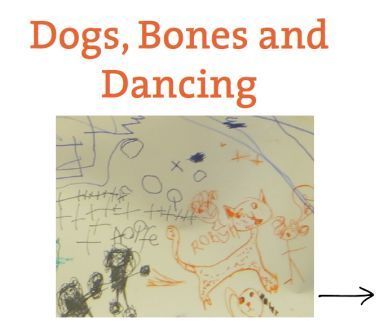A detailed review of this two year work will be published in Nursery World next Monday online.
The article will then appear in the next printed edition. We've had a lovely time discussing it with Annette Rastrone, the writer.
You can sign up to Nursery World online for free (for seven days) to read the article.
Dogs, Bones & Dancing is a free multimedia online publication, made possible through our Youth Music funding. You can read more and sign up to view it by clicking here..
Here is an extract from a reflection by our colleague Professor Colwyn Trevarthen:
"I have spent many years studying the development of babies' talents for exploring interests and feelings with a parent, how they use expressive face, voice and hands to share intimate musicality or dance of proto-conversations and baby songs. They have bodies that cannot stand and walk, but they act with harmonious Self-awareness, understanding the rich language of human movement well, and they learn playful rituals. The infant becomes the two-year-old toddler who is enthralled with the new thrill of independent actions with the whole body on two feet, and with inquisitive ears, eyes and hands discovering a rich new world, and so proud that he or she says "No!" to offers of advice. This is the beginning of a rapid development of acting and imagining, and of communicating stories with joyful movement, leading to mastery of traditions of talk and intricate manipulation skills, including writing. "Dogs, Bones and Dancing" presents a remarkable work by Sightlines Initiative in Kendal with children in nursery and beginning primary school, which richly expands the story I have been trying to understand, in two ways. First, it is clear that, for each of these three-to-fiveyear-olds, the growing vitality of a human body with its many clever parts has become a thrilling adventure. And second, this life adventure is one to be explored in play with companions who love to share the energy and grace of moving, and the new stories it tells. The child asks to be accepted as the author of ideas to be developed with lively company. In doing so he or she is presenting a personality, a named character acting the role of a performer who responds to others' appreciations with confident boldness, or cautious timidity. Three- and four-year-olds like to imagine dramas that discover thrilling experiences and friendships with bold heroes or lovely heroines, or that are excited with fear of monsters which threaten harm."
Colwyn Trevarthen Professor (Emeritus) of Child Psychology and Psychobiology, School of Philosophy, Psychology and Language Sciences, University of Edinburgh Vice-President, British Association for Early Child Education
[the full article is available when you register.]


 Dogs, Bones & Dancing!
Dogs, Bones & Dancing!